Life is truly an amazing journey! When you can combine the interest that day-to-day life brings with an investment and love for dressage and horses, that journey takes on a whole new perspective. Especially with Jeremy.
The equestrian journey takes you down many, many byroads that take you further into life; but instead of heading straight down the highway you are often obliged to go via back roads, some of which are dead ends where you have to do a U-turn and try again. You learn so much about the countryside, about the areas you drive through that you would never have known had you not been obliged to get off the highway when a detour was placed in your way. So it is with every horse you own and train. As they say… it’s the journey, not the destination, that’s important.
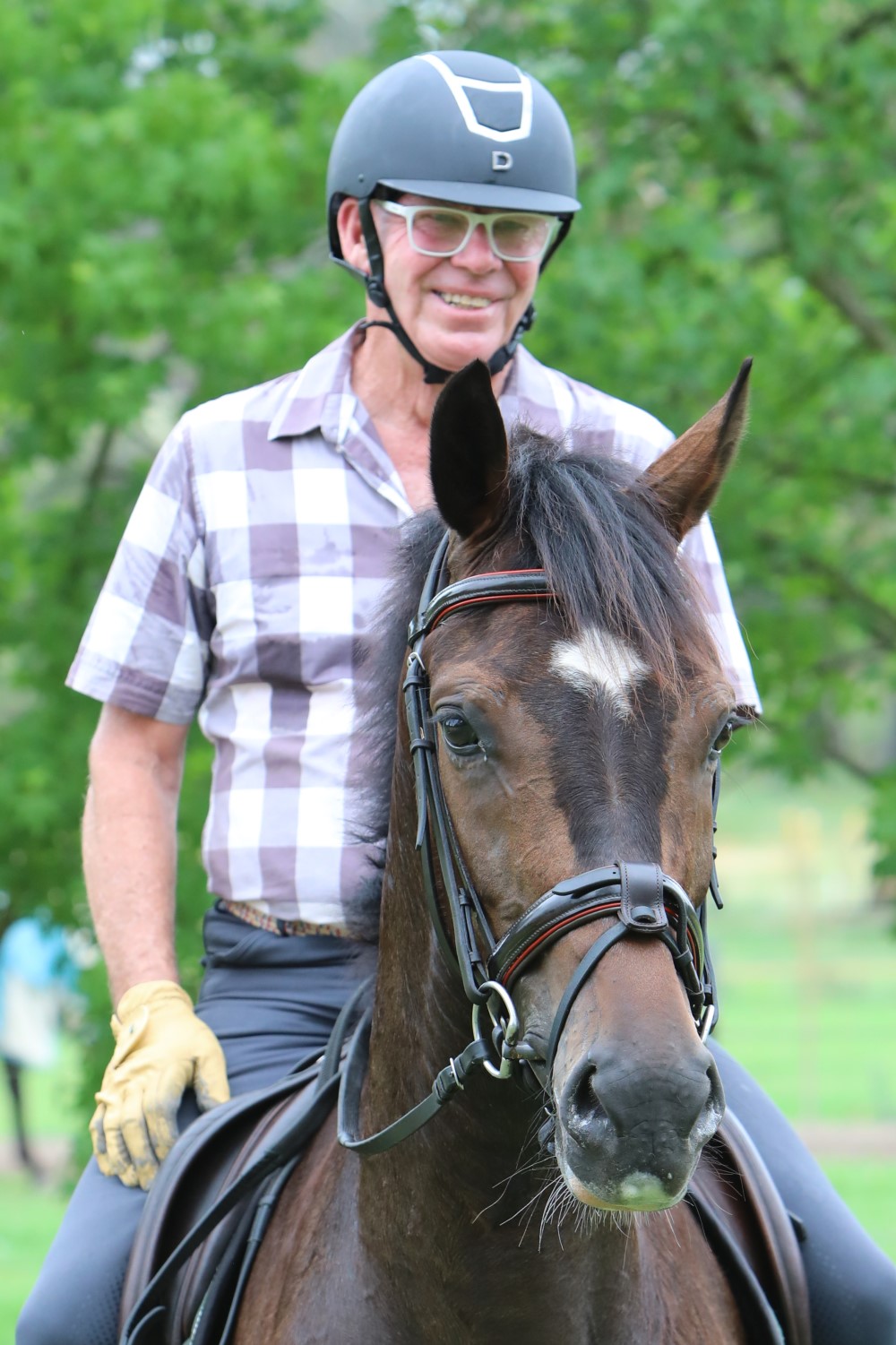
“It is one of those
burrows that I hope
you never have to go down.”
Bloomfield Vision, or ‘Jeremy’ as he is called in the stables, has certainly taken me off the highway. He has encouraged me to explore many villages. I have had a lot of dead ends and U-turns to navigate with him, but I am certainly learning about the terrain and the paths that make me better equipped with his life. He is a truly beautiful horse with a wonderful character, but he has developed headshaking… now here is a detour sign and a very big one! It would be nice if his journey had stayed on the highway, but it hasn’t and as a consequence I have no option but to navigate my way around to get back parallel to that highway again. Time will tell if I actually get back on the highway or not!
For those out there that have never had anything to do with headshaking it is one of those burrows that I hope you never have to go down. Jeremy’s headshaking started off by him having a very irritated nose that he wanted to rub all the time. He didn’t start by flicking his head, but by wanting to rub his nose on anything he could. Some people may have thought, from the outside looking in, that it was just bad behaviour or simply a green four-year-old with some contact issues. I can only liken it to that experience of trying to hold back a sneeze when eventually you have no choice but to do so. For Jeremy, the irritation in his nose, knowing he was not able to stop and rub it on his leg or run over to the fence created great anxiety and eventually he had no choice but to alleviate the discomfort in whatever way he could. A lot of snorting, and if being ridden, he would stop by the arena fence and rub his face frantically.
It was extremely distressing for him and for me as I was not in control; I did try to divert his attention from his itch by making exercises and transitions. I was able at times to divert the anxiety, but he was often beside himself with anxiety about what to do to get rid of the feeling. This, I believe is when he started to flick his head, as somehow this would alleviate the feeling. As a physiotherapist, and after all the testing that was done, I believe that whatever the irritation to his trigeminal nerve was the reason he flipped his head. That nerve runs down the side of the face and over the areas near the airways. Was it the air passing up his nose that triggered it? Who knows what, but it certainly is thought that this is the nerve most likely affected. Nerve pain, as we all know, is terrible. He could feel the pain from the nerve – which could be explained as feeling like an electric shock – coming on, and his only thought was “get ready, I’m going to get a sting!” When this attitude came on, he could only focus on worrying about the sting that was going to happen. Then sure enough, the sting and head flick.
If you need to treat something, firstly you need a diagnosis. This is the most frustrating part. So the investigation trail started by trying to see if there was any sign of a physical problem. We checked his eyes, nose and ears for problems. His nose was scoped as was his throat. There was a minor degree of inflammatory changes in his nostrils, so we treated him with nebulisations and steroids, unfortunately to no avail. I felt it was from his nose or from his sinuses, so his sinuses, his face, jaw and cervical spine were all X-rayed with no abnormalities detected. He had bloods done on several occasions. He had anti-inflammatory nebulisers as well as anti-inflammatory drugs to try to decrease nerve irritation.
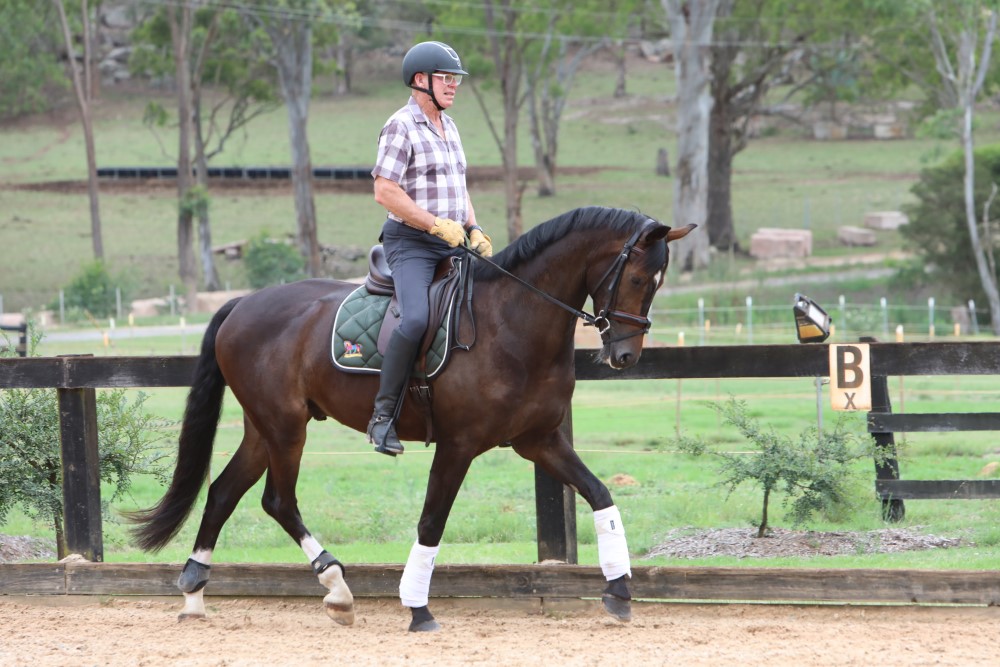
THE ELUSIVE DIAGNOSIS
I have tried so hard to find a diagnosis but to this day have not succeeded. All that could be ascertained is that there was an irritation that sets off this nerve reaction. What creates this irritation to the nerve, who knows. I decided to research diet extensively and we took him off basically everything and started again from scratch. He was taken off the grass and into a sand yard and stable. After a few days it was perhaps a little better as he was also now on no lucerne hay nor chaff as we were advised that perhaps the lucerne can be an irritant. No supplements at all and only teff and oaten hay.
He was not a happy horse at all, losing weight and too irritated to be ridden or even lunged. He didn’t flick his head when he was in the yard but never played in the yard or paddock as with movement came irritation and headshaking! I would put him on the lunge from time to time as it was how I could assess if the headshaking was getting better or worse. It was then trial and error to see if different foods would bring on an allergic reaction and the head flicking becoming worse.
It was Tristan Tucker, who had read the first article I wrote about Jeremey’s condition in the August 2023 issue of Equestrian Life and suggested we see a craniosacral therapist. He sent me a list of ones he knew of in Australia, as he uses these therapists and had success with a headshaker with their treatment. It was a road that I had never been down and was really unaware of the treatment. Eva Kuhl Bornefelt trained in Scandanavia and used to treat horses there but since coming to Australia she has been treating people and specialises also in dogs. She was quite excited to start again with horses and is now seeing several associated riders’ horses with great results.
OPEN TO OPTIONS
I had no idea about craniosacral therapy, yet for some reason I was excited that perhaps it may help this difficult affliction. When push comes to shove, anyone in a crisis is suddenly open to all options. Craniosacral therapy is an alternative treatment in which practitioners use gentle touch to manipulate bone movement, primarily in the skull. I was very interested and excited that it might help, and on meeting Eva she was kind and logical with a great understanding of her ability and belief in her treatment. Eva had no prior knowledge of Jeremy’s history, only that he was a headshaker. She treated Jeremy for one and a half hours and it all still seems very strange to me, but I couldn’t wait to see if there was any difference after a very non-invasive and interesting session.
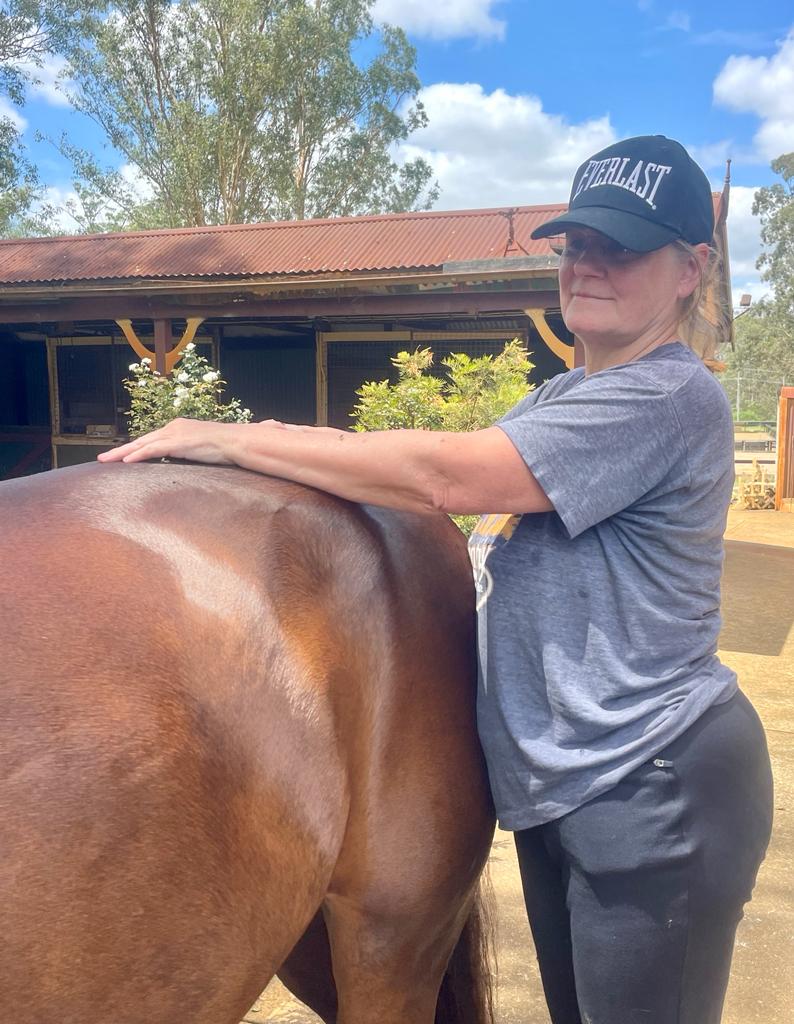
I asked Eva to explain how her treatment works and what she is actually triggering, and she explained that it’s very complex. She uses “multidimensional therapy” (which alongside craniosacral therapy also incorporates elements of movement assessment, meridians and acupoints, fascia and muscle work and multidimensional sensing).
During the treatment, Eva said that she felt that a lot of Jeremey’s problems were from allergic reactions to what he was eating. She spoke about what is high on the list for creating allergic reactions, which could be lucerne, soy meal of any type and sugars. Eva had no prior knowledge of what this horse was like, or what he was being fed. The soybean meal was very interesting because when he began headshaking and was at his worst was when he was on soybean meal. We had taken him off it and his headshaking did start to settle.
“Underlying issues seem to be blockages in certain meridians and associated fascia-muscle lines,” she said. “Meridians are electrical flows supplying the organs and all other tissue of the body along the length of the lines. Emotional trauma, physical injury, toxicity, and pathogens block the flow, which affects the function of the organs and tissues and distorts movement.”
“A likely reason for some or all of the entrenched meridian blockages is metabolic issues, mostly showing as liver stagnation, liver qi (energy) stagnation and probably also thick sticky bile. The liver feels dense and heavy, which has a contracting effect on fascia and tissue in various places. Certain foods like bran, soybean meal and oils seem to be a problem, especially for the liver. Beet greens, which have a thinning effect on bile, feel like they would make the liver lighter.”
Eva was also able to tell me a lot about Jeremy’s attitude, his anxiety, his lack of strength over the backend, and also that she felt he struggled with canter, all of which was true. From her feeling, she was very astute to the fact that his nose and nerves, especially on the right side of his face, were creating problems. She even explained that he would like to remain short in the neck and not take his neck long and down and forwards.
“Part of the head-shaking behaviour is due to irritation in the nose and/or sinuses and or nerves in the area,” she explained. “Some easing of the head-shaking and neck rigidity has come from decompressing the bones in the face and cranium, especially releasing the bones of the upper jaw and deep cranium, some of them from inside the mouth, along with the neck and back of head.
“Another remaining issue in the nose and sinuses could be infection/inflammation. There is a response to fungal infection, which can in part also be due to blocked meridian flow, which causes congestion. This can in turn be due to food sensitivities and metabolic issues.”
AN INTEREST IN CARROTS
The first thing I have to say I noticed was Jeremy’s interest in carrots. Ever since I had owned him, he could not bite off a carrot. Not a hope. On taking him back to his paddock after the treatment I offered him a carrot which he snapped clean in half. I was amazed! I was looking forward to seeing if there was any difference with him being lunged, and to my absolute amazement the next day there was a marked difference, especially in his attitude and lack of anxiety.
Eva watched the horse on the lunge before and after the following treatments, which were every two weeks, and she could explain exactly where the horse was weak, stiff and struggling. She could explain exactly why he wasn’t moving in the way that he could, and she also explained about his brain being somewhat foggy, which it was.
I have to say that this horse has improved and gone from strength to strength in his training and his movement since the treatments. She believed she could help him, and so far it seems she has! Combined with consistent training between sessions, working on strengthening his topline, I am really hanging onto this treatment, and I believe it is absolutely bearing fruit.
Of course, it’s not simply Eva and her treatment that is improving him. There are so many associated reasons, but a lot of her thoughts about feeding and what he should and shouldn’t be on is also helping his affliction. Her treatments also enable me to understand more and realise more how clever she is at assessing gait patterns and balance and the problems that don’t allow it to improve. I have to say that this road is starting to turn back towards the highway! I am very excited and quite happy to coast down this road with positivity and confidence.
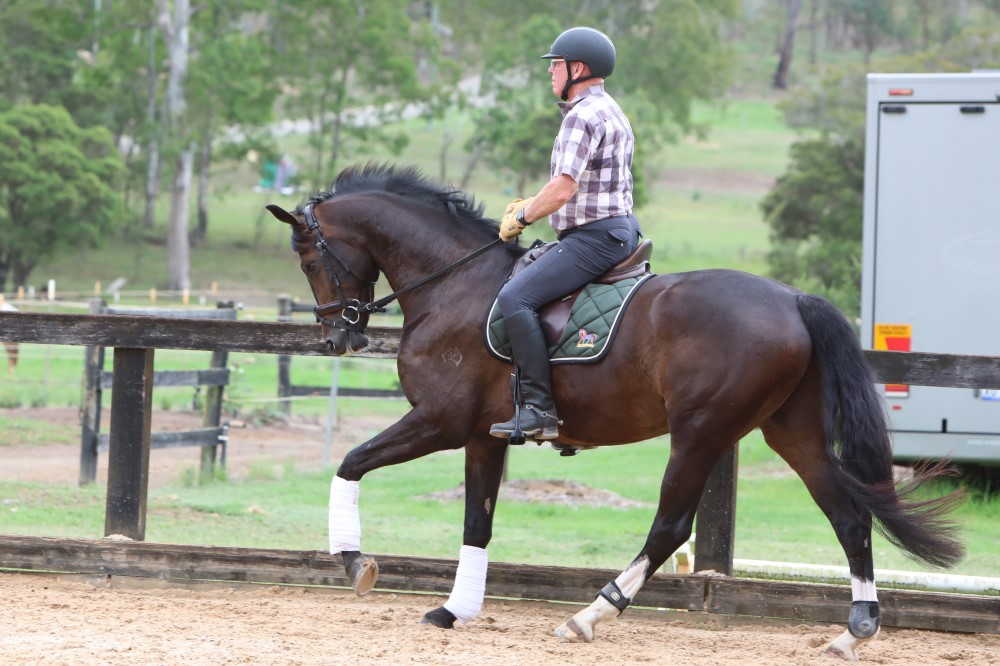
“This horse has
improved and gone
from strength to strength.”
UNFORESEEN CURVED BALL
Just to throw yet another horsey curved ball, Jeremy managed to get his rug pulled over his head from the horse in the yard next to him. He managed to flatten 19 star posts and break a huge strainer post off at ground level! How he didn’t kill himself is amazing. So it was a major stitch-up from out vet and six weeks off as the biggest wound that all but went into his actual gut was where the girth was to go. Again, I have to say that his wonderful attitude yet again shone through as he was the most wonderful patient and not a moment of grief in any treatments did he give us. The wounds healed remarkably well, but having been under lights and in great coat before he was turned out in the paddock (and no stable in the middle of winter to see if it was the stable and shavings that affected him), he grew an amazingly heavy winter coat. Poor Jeremy. He was not happy and nor was his entire system! His wounds healed and the many stitches were removed but he was not able to be worked as the wound near the girth needed more time to settle. He was seriously a sad horse. All the same, so accommodating and a pleasure to be around and now that he could bite off carrots, he thought he was so clever and was on the road to recovery.
When the time came to start to try and ride him again it was exciting yet fraught with trepidation. He certainly did not look like a superstar horse. Lacking muscle and hairy on the outside, but what was on the inside so shone through to me. Truly I have to say that he looked at me with that look of adoration… weird, I know, but just so true. He knew he was being helped and he was accepting. I know at my age and experience I would say that these feelings are sort of out there. Touchy feely and horse whisperish… but for a guy that was never that way and so down the straight and narrow highway, I am so enjoying my openness to treatments I never had time for before. I realise there are so many roads to explore that I once thought were gobbledegook that actually are of benefit to look into. Nothing ventured, nothing gained. I have had my eyes opened that were probably half-shut!
Jeremy is on a very interesting feeding regimen now and his headshaking has definitely improved a lot. He is back in work and very trainable. He is now able to make walk-canter transition, canter-walk transitions; his trot is more forward and improved and he can now actually stretch down and I can also trot around on a long rein. Before Eva saw him it was absolutely impossible to do this. He would not go down and forwards with his frame at all. He always felt with his head high that it decreased the amount of air flow down his nostrils, as I read it. I did try a nose net, but it just irritated the hell out of him and didn’t work for him, but for some it is often a very worthwhile piece of equipment.

During periods of time when he was extremely anxious about being worked, he was not moving around his yard nor playing as a healthy four-year-old should, because it would set the headshaking off. He was losing muscle tone and was not a happy horse. On speaking to a great friend who is a vet and very knowledgeable in these areas – and who also has a horse with a headshaking problem – she explained it is important to give them work. After many hours of discussion, it was decided to start to treat Jeremy with a very small dose of tranquilliser, which slowed the conduction of the nerves.
The dose was exceedingly low, and it was unbelievable the difference in the horse. Not only did it help with his anxiety, but I’m sure it also decreased the triggering of the nerves. We continued with this treatment for several weeks and decreased the amount of tranquilliser day by day. It was very exciting to see the difference. Some would say “how crazy”, but it gave him the chance to settle and realise that work was not uncomfortable. It helped him through a tough time.
He had time to realise the nerve pain was not really as bad as he had come to believe. I couldn’t imagine this much improvement from a horse that was unrideable. He was now very rideable. Tranquillisers have their place… it’s called therapy… therapy is all about improving one’s life!
Of course, we have tried different nosebands and different bridles. It varies with every horse, but we try to keep as much away from the trigger points in areas on his head with nosebands, and with a very comfortable bridle across his poll. One thing that I have continued to do is I lunge him in long side reins, which he accepts exceedingly beautifully every time before I ride him. For some reason, if I get straight on and he feels agitated about his nose, the anxiety levels rise very quickly. On the lunge, he’s able to clear his nostrils and is able to get his breathing going really well in his own way. He lunges beautifully and does occasionally have a little twitchy moment, but he’s learning to cope better and better with it.
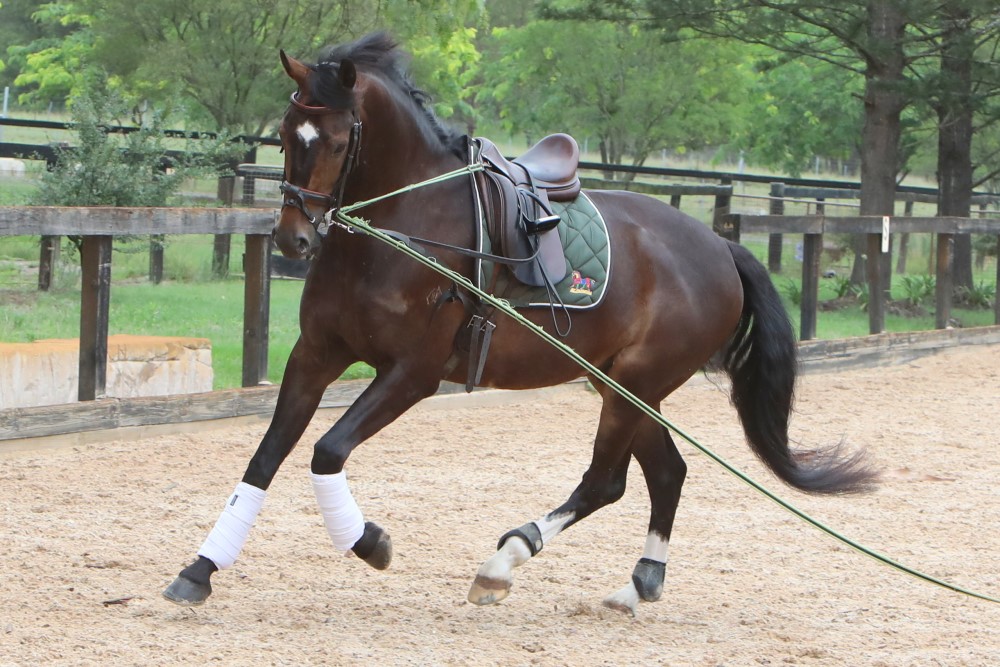
“On the lunge, he’s able
to clear his nostrils…”
DELIGHT UNDER SADDLE
Under saddle, he’s an absolute delight, but to be honest there are times when for whatever reason he can feel a surge coming on. To ride him, I can feel it immediately, not only through the contact, but through his body that wants to flex and run sideways. We are both learning to cope with this very well. I don’t believe it will probably ever go away completely, but what we both have to do is work within the boundaries that this affliction sets. I totally accept it. It’s out of his control and I have to make him feel comfortable that is not going to really hurt him. It doesn’t last very long, but while it is in his head that it’s going to happen, I try to make sure I can now control his neck, keeping him very straight and ride a lot with my leg and cautious rein contact. The better neck control I am gaining and the more confidence he has in my leg to guide him, the better he is becoming.
This journey is truly amazing and I am devoted to every minute of it. He’s a truly beautiful horse who tries very hard. I can only admire him for his ability to have faith in me as rider; to be able to remain calm despite the fact that he goes through moments of unpleasant feelings in his head.
Sometimes I allow him to stop and to rub his nose and side of his face on his knee. After he has done this, it seems to help him relax. Where we are at the moment is that when he feels it coming on and so do I, I don’t let him stop and I don’t let him put his head down or rest – I simply give him a forward exercise to do, be it into canter and medium canter, whether it’s lengthening the strides in the trot, but always on a straight line, not with any lateral work involved at that time. These exercises distract his mind a little from what he thinks might happen, and it’s progressing very well. As much as he cannot control when it happens, what we can work on is ways around his reactions to what might happen.
I guess you could cool it diversion therapy. Never ever has he been disciplined for flicking his head nor had any auxilliary aids to stop him from moving his head around. It is very important, I believe, that you cannot discipline these reactions. You then have a double-edged sword because he worries about the affliction and then he would also worry if he was going to be disciplined for doing it; it would be terrible.
I have taken him to another property to ride him for the first time. He was immaculately behaved and I had a wonderful time. I can’t believe my luck with working through this problem. It’s always about working with the horse. And thinking a little like him. Putting myself in his position and then reassessing ways around any problem. Of all the horses I’ve had, I have to say that Jeremy is probably the most beautiful both on the inside and the outside. There is no pressure on me to compete any more – not saying that perhaps one day I might – but without this pressure my attitude towards training is so much better, I make the most of every little improvement I feel and see in my horse. All the experience in all the years I’ve had with all the tools I’ve got in my kit, I’m loving being able to use them with absolute obvious effect.
It’s an exciting time and I thank everybody who sent emails and messages in regards to this affliction. There are many, many things that can be done. Every horse is totally individual. It is very frustrating at times, not only for me as an owner and a rider, but also for poor Jeremy who becomes the victim of something he had no choice in. Could it have been the cold weather in the winter affecting his nostrils? Could it have been a weirdo grass? Could it have been a tree? Could it be the shavings? Who would know what sets this off. If only we did know. The diet he is on now will not change. I’m very happy with how well he is doing on this diet and we will just continue, along with Eva, helping me every few weeks in regards to this and getting more and more confident. I have not needed to use any form of sedation, as mild as it was, for a couple of months now. He is on no other drugs at all. No anti-inflammatories, he is simply on a good, logical diet and all seems to be heading along the right road.

I have set a goal that I would so love to take him to Dressage by the Sea at Willinga Park in February. Not to be competitive but to enjoy the most wonderful venue and competition! He would love to be a part of that and I just want to take him as a partner and enjoy a venue that is simply stunning and one that makes you feel privileged and proud to be there. What can I say but I have never, ever enjoyed a challenge that headshaking has brought to the fore! Its exasperating. It’s dementing. It’s depressing. It’s discouraging and disheartening, but I look at it as a challenge and a task to work through and give it my all. Go down every back street and never negate a therapy. Nothing ventured, nothing gained!
Look at all roads, avenues and byways. Learn by looking around off the highways. Never be afraid to accept the alternatives and always have an open mind to all therapies. Valegro was a headshaker! Enjoy every ride and every moment you spend with a horse. Put yourself in their situations and realise their attitudes!
This article is an account of personal experience and based on anecdotal evidence; it is not intended as health advice. As with any equine health concern, always consult your veterinarian regarding available treatment options for your horse. EQ
YOU MIGHT ALSO LIKE TO READ:
Jeremy Has Me Scratching My Head – Equestrian Life, August 2023
Roger Smitten by a Vision – Equestrian Life, June 2023

